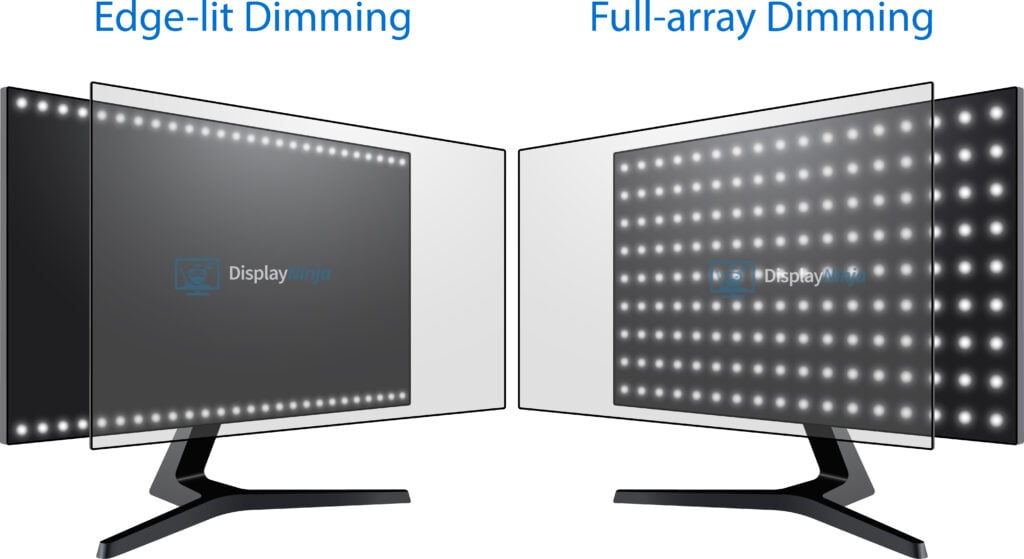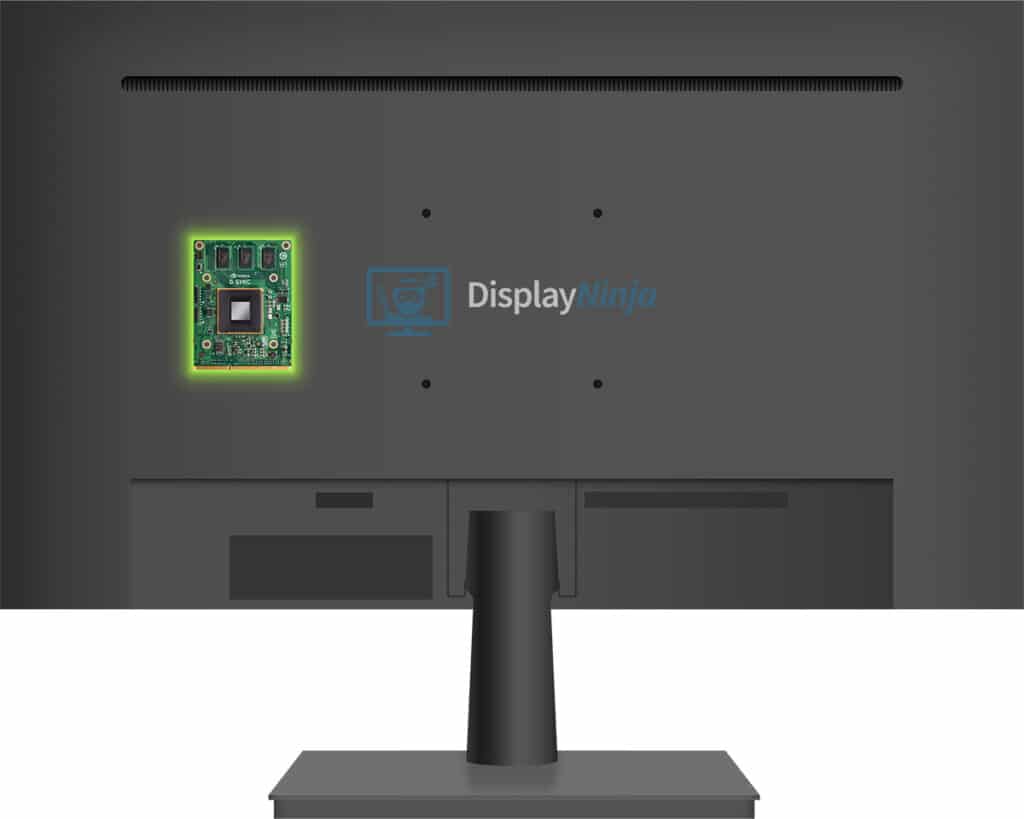Bottom Line
The ASUS PG27AQN is the best gaming monitor if you’re looking for a single display for competitive gaming and other use (office-related work, photo/video editing, AAA gaming, etc.). It’s not particularly good for HDR though.
The ASUS ROG Swift PG27AQN is the first 1440p monitor with a refresh rate of 360Hz, which makes it the ideal display for those who enjoy both competitive and graphically-oriented games!
Image Quality
For a lot of gamers, the 1440p resolution is perfect for 27″ sized screens. The image quality is almost as good as that of 4K UHD at this screen size, but since 1440p is significantly less demanding to drive, maintaining a higher frame rate is a lot easier.
Further, with a pixel density of 108.79 PPI (pixels per inch), you get plenty of screen real estate with sharp details and text – without having to use any scaling.
The ASUS PG27AQN uses an IPS panel with a wide 98% DCI-P3 color gamut, which is equivalent to around 135% sRGB gamut size, resulting in rich and vibrant colors.
There’s also an sRGB mode under the ‘Display Color Space’ option in the OSD (On-Screen Display) menu that clamps the gamut down to 100% sRGB in case you want more accurate colors for SDR content.
What’s more, the display is factory-calibrated at Delta E < 2, which in addition to the 178° wide viewing angles of IPS technology, results in accurate and consistent color output fit for professional color-critical work!
As expected from an IPS display, the static contrast ratio amount to 1,000:1 and there’s some IPS glow, so blacks won’t appear quite as deep as that of VA panels with ~3,000:1 contrast ratio, but VA monitors have other drawbacks and this 1440p 360Hz form factor is only available as an IPS variant anyway, at least for now.
Moving on, the ASUS PG27AQN monitor has a specified SDR peak brightness of 400-nits (though it can reach up to 500-nits), so it won’t have any issues mitigating glare in particularly well-lit rooms.
It also supports HDR (High Dynamic Range) and has VESA’s DisplayHDR 600 certification. However, since it only has 32 edge-lit dimming zones, you’re not getting the true HDR viewing experience.

Its wide color gamut and 600-nit peak brightness in HDR mode can make some content a lot better than SDR, and local dimming can be helpful in scenes with dark and bright objects far apart.
On the other hand, in particularly demanding scenes, you might find that enabling HDR causes more distractions than improvements, so whether you should turn HDR and local dimming (Variable Backlight) on or off will vary from content to content.
Performance
The ASUS ROG Swift PG27AQN uses an Ultrafast IPS panel by AU Optronics paired with the new Dual-Layer Voltage Driver, which together makes for a rapid pixel response time speed required to keep up with the 360Hz refresh rate.
There’s no noticeable trailing behind fast-moving objects at 360Hz, while the dedicated G-SYNC module with variable overdrive ensures no overshoot at lower refresh rates, as well as imperceptible ~1ms input lag and tear-free gameplay up to 360FPS.

Of course, to actually benefit from 360Hz, you’ll need to be able to achieve such high frame rates, which requires a fast CPU. With an Intel 12th Gen or Ryzen 5000 series CPU and a decent GPU, this won’t be an issue with low/medium settings at 1440p in the popular eSports titles.
The monitor also supports Adaptive-Sync over DisplayPort if you wish to use a variable refresh rate with an AMD GPU.
There are four response time overdrive modes: Off, Normal, Esports and Extreme. Esports and Extreme both add noticeable inverse ghosting, so we recommend sticking with Normal for the best results.
The ASUS PG27AQN also supports NVIDIA’s new ULMB 2 technology, which uses backlight strobing to improve motion clarity at the cost of image brightness.
It only works at fixed refresh rates (up to 360Hz). The brightness is reduced to 275-nits, which is still plenty bright for most users. There’s also minimum crosstalk, so the overall backlight strobing performance is excellent.
If you have an AMD GPU, you’ll need to remove VRR using CRU to enable ULMB 2.
The backlight of the monitor is flicker-free (unless ULMB is enabled) and there’s an integrated low-blue light filter.
Features

At the rear of the monitor, there’s the power button, three buttons for shortcuts and a directional joystick for quick and easy navigation through the OSD menu.
The ASUS PG27AQN supports NVIDIA Reflex Latency Analyzer, which allows you to measure input latency if you have a compatible mouse connected to the red-colored USB port on the monitor.
Other gaming features include Dark Boost (improves visibility in dark scenes by altering the gamma curvature), crosshair overlays, various picture presets, on-screen timers and a refresh rate tracker.
Besides the standard image settings (brightness, contrast, color temperature, etc.), you’ll also find some advanced tools, including five gamma presets, 6-axis saturation and Auto Input Detection.
There’s also an integrated light sensor that can automatically adjust the screen brightness according to ambient lighting.
Next, the monitor has an interesting feature called Esports Dual-Format. Under the Aspect Control option in the OSD menu, you’ll find 25″ Mode, which will make the ASUS PG27AQN display the image as a 25″ display with black bars around it.

In this mode, you can select either 2368×1332 resolution or 1920×1080, though the latter ends up being blurry.
Design & Connectivity

The stand of the monitor is robust and versatile with up to 100mm height adjustment, 90° pivot, +/- 25° swivel, -5°/20° tilt and 100x100mm VESA mount compatibility, while the screen has a light matte anti-glare coating that eliminates reflections without making the image too grainy.
The G-SYNC module also has a cooling fan, but it’s pretty quiet. Of course, if you’re in a silent room and have a silent PC rig running, you will be able to hear it. With headphones, speakers, or any other background noise, it’s not an issue.
Connectivity options include DisplayPort 1.4 with DSC, three HDMI 2.0 ports (limited to 144Hz), a headphone jack and a dual-USB 3.0 hub.
Price & Similar Monitors
The ASUS PG27AQN can be found for $650, which is understandable given its specifications and the fact that it’s the only such display available.
Acer also has a model based on the same panel and similar features, the Predator XB273UF.
Looking for something cheaper with similar motion clarity? Check out the ViewSonic XG2431 and the BenQ XL2566K.
You should also consider a 1440p 360Hz OLED display, such as the MSI MAG 271QPX – and a 1080p 540Hz TN eSports gaming monitor, such as the ASUS PG248QP.
Note that ASUS will also release a 1440p 360Hz IPS monitor with G-SYNC Pulsar (VRR and MBR at the same time) in 2025 or early 2026.
Conclusion
All in all, the ASUS ROG Swift PG27AQN is one of the best gaming monitors out there. It’s particularly great if you’re a serious competitive player who also wants an excellent display for other use.
Specifications
| Screen Size | 27-inch |
| Resolution | 2560×1440 (QHD) |
| Panel Type | IPS |
| Aspect Ratio | 16:9 (Widescreen) |
| Refresh Rate | 360Hz |
| Response Time | 1ms (GtG) |
| Response Time (ULMB 2) | 1ms (MPRT) |
| Adaptive-Sync | G-SYNC (30-360Hz) + Adaptive-Sync |
| Ports | DisplayPort 1.4, 3x HDMI 2.0 |
| Other Ports | Headphone Jack, 2x USB 3.0 |
| Brightness | 400 cd/m² |
| Brightness (HDR) | 600 cd/m² |
| Contrast Ratio | 1000:1 (static) |
| Colors | 1.07 billion (8-bit + FRC) 98% DCI-P3 |
| HDR | DisplayHDR 600 |
| Local Dimming | 32-zone edge-lit |
| VESA | Yes (100x100mm) |
The Pros:
- High pixel density, wide color gamut, consistent colors, sRGB mode
- Quick response time, low input lag
- Plenty of gaming features including G-SYNC up to 360Hz
- Fully ergonomic stand, USB hub
The Cons:
- IPS glow and mediocre contrast ratio (as expected from this panel technology)




